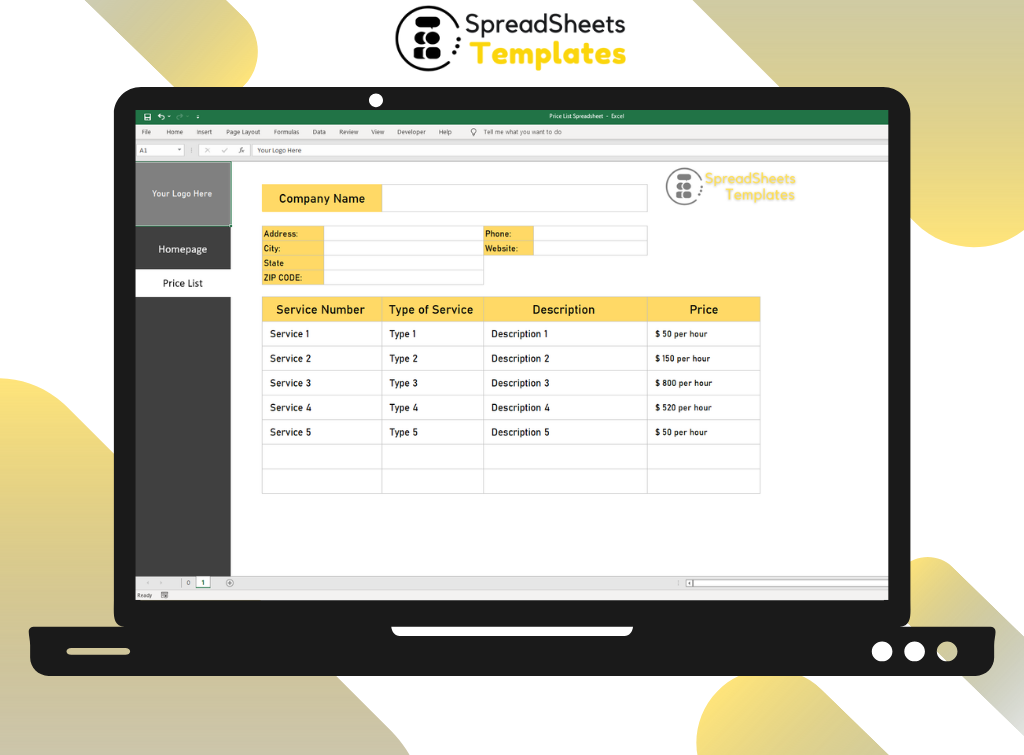Price List Spreadsheet Leave a comment
The Ultimate Guide to Price List Spreadsheets: Everything You Need to Know
Introduction
In today’s business landscape, managing and organizing prices can be a complex task. Whether you run a small business or work in a large organization, having an efficient system to keep track of prices is crucial. One of the most popular tools for this purpose is a Price List Spreadsheet. This comprehensive guide will walk you through everything you need to know about Price List Spreadsheets, including their benefits, how to create one, and tips for optimizing their usage.
Table of Contents
-
- What is a Price List Spreadsheet?
- The Benefits of Using Price List Spreadsheets
- How to Create a Price List Spreadsheet
- Tips for Optimizing Your Price List Spreadsheet
- Common Challenges and Solutions
- Integrating Price List Spreadsheets with Other Tools
- Price List Spreadsheet vs. Traditional Methods
- Best Practices for Maintaining Price List Spreadsheets
- Price List Spreadsheet Automation
- How Price List Spreadsheets Improve Business Efficiency
- Price List Spreadsheet Security Measures
- Tracking Price Changes with Spreadsheets
- Price List Spreadsheet Templates
- Price List Spreadsheet Examples
- Calculating Profit Margins with Price List Spreadsheets
- Price List Spreadsheet for E-commerce Businesses
- Price List Spreadsheet for Service-based Businesses
- Price List Spreadsheet for Manufacturers
- Price List Spreadsheet for Retailers
- Price List Spreadsheet for Freelancers
- Price List Spreadsheet for Contractors
- Price List Spreadsheet for Consultants
- Price List Spreadsheet for Distributors
- Price List Spreadsheet for Wholesale Businesses
- Price List Spreadsheet for Importers/Exporters
1. What is a Price List Spreadsheet?
A Price List Spreadsheet is a digital document created using spreadsheet software like Microsoft Excel or Google Sheets. It is designed to store, organize, and manage product or service prices in a structured format. With a Price List Spreadsheet, businesses can easily access and update pricing information, calculate profit margins, analyze pricing trends, and streamline pricing-related tasks.
2. The Benefits of Using Price List Spreadsheets
Using Price List Spreadsheets offers several advantages for businesses. Here are some key benefits:
- Centralized Price Management: Price List Spreadsheets provide a centralized location to manage and update prices, eliminating the need to search through multiple files or systems.
- Easy Access and Navigation: Spreadsheets allow users to quickly search for specific products or services and navigate through the price list effortlessly.
- Efficient Pricing Analysis: With the ability to sort, filter, and perform calculations, Price List Spreadsheets enable businesses to analyze pricing data and make informed decisions.
- Time and Cost Savings: Automating price calculations and updates with Price List Spreadsheets reduces manual effort, saving time and minimizing errors.
- Version Control: Spreadsheets offer version control features, allowing businesses to track and compare price changes over time.
- Flexibility and Customization: Price List Spreadsheets can be tailored to meet specific business needs, accommodating various pricing models and formats.
3. How to Create a Price List Spreadsheet
Creating a Price List Spreadsheet is a straightforward process. Follow these steps to get started:
- Choose a Spreadsheet Software: Select a spreadsheet software that suits your needs, such as Microsoft Excel or Google Sheets.
- Define Your Price List Structure: Determine the columns and data fields you want to include in your price list. Common fields include product name, SKU, description, cost price, selling price, and profit margin.
- Create the Spreadsheet: Open a new spreadsheet document and add column headers for each data field.
- Enter Product/Service Information: Enter the relevant details for each product or service in the corresponding rows.
- Format and Customize: Apply formatting, such as bold or italic text, to emphasize headers or highlight specific information.
- Set Formulas and Calculations: Use formulas to calculate profit margins, apply discounts, or perform other pricing-related calculations.
- Save and Update: Save your Price List Spreadsheet in a secure location, and regularly update it with any price changes or additions.
4. Tips for Optimizing Your Price List Spreadsheet
To maximize the efficiency and effectiveness of your Price List Spreadsheet, consider the following tips:
- Use Conditional Formatting: Apply conditional formatting to highlight specific price ranges, identify outliers, or draw attention to significant changes.
- Utilize Data Validation: Set up data validation rules to ensure accurate data entry and prevent errors or inconsistencies.
- Implement Version Control: Create separate tabs or sheets within your spreadsheet to track different versions of the price list, enabling easy comparison and analysis.
- Backup Your Spreadsheet: Regularly back up your Price List Spreadsheet to prevent data loss in case of software malfunctions or accidental deletions.
- Protect Sensitive Information: If your price list contains confidential data, use password protection or encryption to safeguard it from unauthorized access.
- Regularly Review and Update: Set aside dedicated time to review and update your Price List Spreadsheet to ensure it remains accurate and up to date.
5. Common Challenges and Solutions
While using Price List Spreadsheets can greatly simplify pricing management, businesses may encounter some challenges along the way. Here are a few common issues and their solutions:
- Data Entry Errors: Mistakes in data entry can lead to incorrect prices. Implement data validation rules and double-check entries to minimize errors.
- Pricing Inconsistencies: Inconsistent pricing across products or services can confuse customers. Regularly review and compare prices to maintain consistency.
- Complex Pricing Models: If your business has complex pricing structures, consider using advanced spreadsheet functions or seeking assistance from a professional to ensure accuracy.
- Collaboration and Access: When multiple team members need access to the Price List Spreadsheet, use cloud-based solutions like Google Sheets to facilitate real-time collaboration.
6. Integrating Price List Spreadsheets with Other Tools
Price List Spreadsheets can be integrated with other tools and software to enhance their functionality. Here are a few examples:
- Customer Relationship Management (CRM) Software: Connect your Price List Spreadsheet with your CRM system to streamline pricing and quoting processes.
- E-commerce Platforms: Integrate your Price List Spreadsheet with your e-commerce platform to automatically update prices and inventory levels.
- Accounting Software: Link your Price List Spreadsheet with your accounting software to synchronize pricing data and streamline financial processes.
7. Price List Spreadsheet vs. Traditional Methods
Compared to traditional methods of managing prices, Price List Spreadsheets offer numerous advantages. Here’s a comparison:
| Price List Spreadsheets | Traditional Methods |
|---|---|
| Centralized price management | Manual price lists distributed across multiple files or systems |
| Easy access and navigation | Time-consuming search for pricing information |
| Efficient pricing analysis | Limited data analysis capabilities |
| Time and cost savings | Increased manual effort and potential for errors |
| Version control | Difficulty in tracking and comparing price changes |
| Flexibility and customization | Limited adaptability to changing business needs |
8. Best Practices for Maintaining Price List Spreadsheets
To ensure your Price List Spreadsheet remains accurate and effective, follow these best practices:
- Regularly update prices to reflect market changes and cost fluctuations.
- Conduct periodic audits to verify the accuracy of pricing information.
- Maintain a clear and consistent naming convention for products or services.
- Back up your Price List Spreadsheet regularly to prevent data loss.
- Train team members on proper spreadsheet usage and data entry guidelines.
- Document any formula or calculation changes to ensure transparency and traceability.
9. Price List Spreadsheet Automation
Automation can further streamline your price management processes. Consider the following automation options:
- Use formulas and functions to automatically calculate profit margins, apply discounts, or determine pricing tiers.
- Implement macros or scripts to automate repetitive tasks, such as updating prices or generating reports.
- Explore pricing software solutions that integrate with Price List Spreadsheets for advanced automation capabilities.
10. How Price List Spreadsheets Improve Business Efficiency
Price List Spreadsheets contribute to improved business efficiency in several ways:
- Time Savings: Automating price calculations and updates eliminates the need for manual data entry, saving valuable time.
- Streamlined Processes: Centralizing pricing information in one spreadsheet simplifies access and navigation, reducing inefficiencies.
- Accurate Pricing Analysis: With data analysis features, businesses can gain insights into pricing trends, optimize profit margins, and make data-driven decisions.
- Enhanced Collaboration: Cloud-based Price List Spreadsheets facilitate real-time collaboration, enabling multiple team members to work simultaneously on pricing tasks.
11. Price List Spreadsheet Security Measures
To ensure the security of your Price List Spreadsheet and the confidentiality of pricing information, consider the following security measures:
- Password Protection: Set a strong password to restrict access to your spreadsheet.
- Encryption: Use encryption tools to encrypt sensitive pricing data within the spreadsheet.
- Limited Access: Grant access only to authorized personnel who require it for their roles.
- Regular Backups: Back up your Price List Spreadsheet regularly to prevent data loss in case of software failures or accidental deletions.
12. Tracking Price Changes with Spreadsheets
Price List Spreadsheets offer an effective way to track price changes over time. Here’s how you can use them to monitor pricing fluctuations:
- Create a separate column in your spreadsheet to record the date or timestamp of each price change.
- Use conditional formatting to highlight recent price updates for quick identification.
- Implement a formula that calculates the price difference between the current and previous versions, providing insights into the magnitude of the change.
- Leverage charting features to visualize price trends and fluctuations.
13. Price List Spreadsheet Templates
If you’re new to Price List Spreadsheets or prefer a head start, you can find a variety of templates online. Many spreadsheet software applications offer pre-built templates specifically designed for price management.
14. Price List Spreadsheet Examples
To give you a better idea of how Price List Spreadsheets can be structured and utilized, here are a few examples:
- Example 1: Product-based Price List Spreadsheet with columns for product name, SKU, cost price, selling price, and profit margin.
- Example 2: Service-based Price List Spreadsheet with columns for service description, hourly rate, fixed fee, and total cost.
- Example 3: Wholesale Price List Spreadsheet with columns for product name, SKU, quantity-based pricing tiers, and discounts.
15. Calculating Profit Margins with Price List Spreadsheets
Profit margin calculation is an essential aspect of pricing management. Here’s a formula to calculate profit margin in your Price List Spreadsheet:
Profit Margin = (Selling Price - Cost Price) / Selling Price * 100
This formula calculates the percentage profit margin based on the selling price and cost price.
16. Price List Spreadsheet for E-commerce Businesses
E-commerce businesses can leverage Price List Spreadsheets to manage pricing for their online stores. Key considerations include:
- Syncing the Price List Spreadsheet with your e-commerce platform to automate price updates.
- Tracking inventory levels and automatically adjusting prices based on availability.
- Incorporating shipping costs and discounts into the spreadsheet calculations.
17. Price List Spreadsheet for Service-based Businesses
Service-based businesses can utilize Price List Spreadsheets to streamline pricing for their offerings. Consider including:
- Service descriptions, rates, and pricing tiers based on duration or complexity.
- Additional charges or discounts based on specific service features.
- Customization options for clients and corresponding pricing adjustments.
18. Price List Spreadsheet for Manufacturers
Manufacturers can benefit from Price List Spreadsheets by efficiently managing product prices. Key features may include:
- SKU codes for each product to ensure accurate identification.
- Material costs, production expenses, and profit margin calculations.
- Bulk pricing or volume discounts for wholesale customers.
19. Price List Spreadsheet for Retailers
Retailers can utilize Price List Spreadsheets to maintain consistency and accuracy in their pricing strategies. Consider incorporating:
- Product categories and subcategories for easy organization and navigation.
- Regularly updated supplier costs and retail prices.
- Seasonal discounts or promotional pricing options.
20. Price List Spreadsheet for Freelancers
Freelancers can use Price List Spreadsheets to streamline their pricing and quoting processes. Key elements to include are:
- Service descriptions, hourly rates, and project-based pricing options.
- Upfront or recurring fees, such as retainer charges or consultation fees.
- Customizable templates to generate professional-looking quotes for clients.
21. Price List Spreadsheet for Contractors
Contractors can leverage Price List Spreadsheets to manage their pricing for different projects. Consider including:
- Material costs, labor rates, and pricing tiers for different project sizes or complexities.
- Additional charges for specialized services or custom requests.
- Template customization for generating project estimates and invoices.
22. Price List Spreadsheet for Consultants
Consultants can utilize Price List Spreadsheets to structure and manage their service offerings. Key elements to consider include:
- Service packages with fixed pricing or hourly rates.
- Additional charges for travel expenses or specialized services.
- Integration with time tracking tools for accurate invoicing.
23. Price List Spreadsheet for Distributors
Distributors can optimize their pricing processes with Price List Spreadsheets. Key considerations include:
- SKU codes and product descriptions for easy identification.
- Quantity-based pricing tiers for volume discounts.
- Integration with inventory management systems for real-time stock updates.
24. Price List Spreadsheet for Wholesale Businesses
Wholesale businesses can benefit from Price List Spreadsheets to manage pricing for their buyers. Key features may include:
- Customer-specific pricing based on contract terms or negotiated agreements.
- Minimum order quantities and corresponding price breaks.
- Discount structures for long-term or high-volume customers.
25. Price List Spreadsheet for Importers/Exporters
Importers and exporters can utilize Price List Spreadsheets to streamline their pricing and international trade processes. Consider including:
- Currency conversion rates for accurate pricing in different markets.
- Tariffs, taxes, and shipping costs for each destination.
- Integration with logistics software for streamlined import/export pricing.
FAQs (Frequently Asked Questions)
FAQ 1: What is the Price List Spreadsheet?
A Price List Spreadsheet is a digital document created using spreadsheet software to store and manage product or service prices in a structured format.
FAQ 2: Which software can I use to create a Price List Spreadsheet?
Popular spreadsheet software options include Microsoft Excel, Google Sheets, Apple Numbers, and LibreOffice Calc.
FAQ 3: Can I customize the Price List Spreadsheet to fit my business needs?
Yes, Price List Spreadsheets are highly customizable. You can add or remove columns, modify formulas, and apply formatting based on your specific requirements.
FAQ 4: How often should I update my Price List Spreadsheet?
It is recommended to update your Price List Spreadsheet regularly to reflect changes in costs, market conditions, or pricing strategies. Aim for a consistent and timely update schedule.
FAQ 5: Can I share my Price List Spreadsheet with others?
Yes, you can share your Price List Spreadsheet with team members or collaborators. Most spreadsheet software allows you to control access permissions and collaborate in real-time.
FAQ 6: Is it necessary to use a Price List Spreadsheet for my business?
While not mandatory, using a Price List Spreadsheet can greatly simplify price management and provide a centralized platform for efficient pricing analysis and updates.
Conclusion
A Price List Spreadsheet is a valuable tool for businesses of all sizes and industries to manage their product or service pricing effectively. By centralizing pricing information, automating calculations, and streamlining processes, Price List Spreadsheets contribute to enhanced efficiency, accuracy, and profitability. Whether you’re a retailer, manufacturer, freelancer, or distributor, utilizing a Price List Spreadsheet can help you maintain consistency, make informed pricing decisions, and ultimately drive business success.
Remember to regularly update and review your Price List Spreadsheet to ensure accuracy, incorporate security measures to protect sensitive pricing information, and leverage automation and integration options to optimize its functionality. By following best practices and utilizing the capabilities of Price List Spreadsheets, you can effectively manage your pricing and gain a competitive edge in your industry.


